The
ever-obliging ajuga
Jane Wrigglesworth
extols the virtues of a shade-loving, frost-hardy ground cover that
bears dainty flowers come spring.
Ajuga reptans
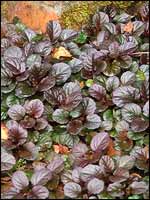 If
ever there was a ground cover to celebrate, ajuga must surely be
it. This is a plant whose foliage is showy enough to hold its own.
Soft, spatulate leaves come in green, purple, bronze, pinky-green
or variegated cream and maroon, and a single plant can spread to
form a vast carpet of leaves about 5-8 cm high. Think of your common
garden variety mint (from which family the ajuga belongs to) and
you get some idea as to how prolific this plant can be. If
ever there was a ground cover to celebrate, ajuga must surely be
it. This is a plant whose foliage is showy enough to hold its own.
Soft, spatulate leaves come in green, purple, bronze, pinky-green
or variegated cream and maroon, and a single plant can spread to
form a vast carpet of leaves about 5-8 cm high. Think of your common
garden variety mint (from which family the ajuga belongs to) and
you get some idea as to how prolific this plant can be.
Certainly, the foliage
may be your main reason to grow ajuga, but come spring or early
summer the plant sends up spikes of dainty white, pink or deep blue
flowers, up to 20 cm high in some cultivars. In favourable conditions,
flowering will even continue for up to three months.
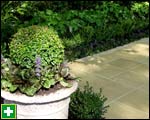 If
you need one more reason to convince you of this plant's worthiness,
it would have to be that ajugas are particularly enthusiastic about
shade. Even the most dreaded shady spot in the garden can be transformed
by the humble ajuga. And whilst we're on the subject of positive
attributes, the ajuga is also frost hardy. In fact, it's pretty
much trouble free. If
you need one more reason to convince you of this plant's worthiness,
it would have to be that ajugas are particularly enthusiastic about
shade. Even the most dreaded shady spot in the garden can be transformed
by the humble ajuga. And whilst we're on the subject of positive
attributes, the ajuga is also frost hardy. In fact, it's pretty
much trouble free.
It would be fair, however,
to issue a warning at this stage. Given perfect conditions, the
ajuga may be considered, by some, to be a weed. In fact, neighbouring
plants can find themselves being smothered by this prolific
grower, but if this is the case, the ajuga can easily be controlled
by regularly snipping.
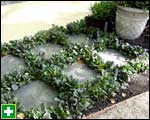 Those
"perfect conditions" I refer to are moist soil and shelter from
the strong sun, although you may find the variegated and bronze-leafed
forms will develop their colour better in the sun. Ajuga will tolerate
short periods of drought, but its shallow root system means it requires
moisture, particularly during hot summer days. Those
"perfect conditions" I refer to are moist soil and shelter from
the strong sun, although you may find the variegated and bronze-leafed
forms will develop their colour better in the sun. Ajuga will tolerate
short periods of drought, but its shallow root system means it requires
moisture, particularly during hot summer days.
Whilst warnings are often
issued against the pesky snail, I have never before found a snail
attacking the leaves of my plants. Perhaps this is because I have
rengarenga (Arthropodium candidum) growing nearby, a veritable
feast for these slimy molluscs. Nonetheless, snails should be regarded
with some suspicion if seen in the near vicinity of your ajuga.
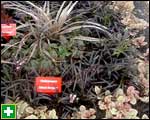 Ajugas
can be used in all sorts of situations — on moist banks, in
between pavers, at the base of potted standards or topiary, beside
paths, at the front of borders, or even to offset other plants.
Ajuga 'Burgundy Lace' (above right) looks particularly stunning
against the black mondo grass or other contrasting foliage. Ajugas
can be used in all sorts of situations — on moist banks, in
between pavers, at the base of potted standards or topiary, beside
paths, at the front of borders, or even to offset other plants.
Ajuga 'Burgundy Lace' (above right) looks particularly stunning
against the black mondo grass or other contrasting foliage.
As Ajuga reptans
spreads by surface runners (like a strawberry plant), it is very
easy to propagate by division. Just pick off a couple of new plants
and transplant to another area of your garden.
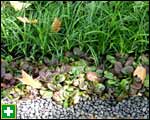 Make
sure there is no soil in the crown of your plant, as ajugas are
susceptible to crown rot when wet and soggy. This is caused by a
fungus that attacks the plant, causing it to wilt and die. Make
sure there is no soil in the crown of your plant, as ajugas are
susceptible to crown rot when wet and soggy. This is caused by a
fungus that attacks the plant, causing it to wilt and die.
On the whole, though,
ajugas are a breeze to grow. They don't mind frost nor do they mind
shade. They grow relatively quickly to cover unsightly spots. They
even possess a favourable bloom. What more, I ask, could you possibly
want?
Jane Wrigglesworth
Reproduced
with permission from NZOOM Home and Garden content,
from the previous
website of 
The views expressed here are not necessarily those of the RNZIH
 |
|
HOME
AND GARDEN |
|
|
More
Garden Articles
|